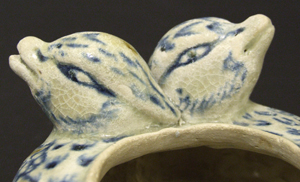
VIETNAMESE LATE 15th or 16th CENTURY Vietnamese Pottery
A Rare Vietnamese Blue and White Pottery Double Duck Water Dropper, Late 15th to 16th Century, Probably from the Chu Dou Kilns. Realistically Modelled as a Pair of Conjoined Mandarin Ducks and Painted Cobalt Blue with Small Among of Pale Yellowish Green on the Wings.
SOLD
- Condition
- In very good condition, some roughness to the extremities due to glaze loss.
- Size
- Length : 12.8 cm (5 inches) Width : 11.2 cm (4 1/3 inches).
- Provenance
- The Piccus Collection of Vietnamese Ceramics R & G McPherson Antiques The John Drew Collection of Chinese and Japanese Ceramics.
- Stock number
- 23332
Information
With a fitted box from the Piccus Collection.
The prototype for this rare Vietnamese model are Ming blue and white porcelain double duck water droppers produced in Jingdezhen during the late 15th and early 16th centuries. These were exported widely over South East Asia and would have been familiar in Vietnam.
Vietnamese Pottery From the Chu Dou Kilns :
Chu Dou Kilns, six kilometres from Hai Dong was the largest centre of ceramic production in medieval Vietnam. The quality of the ceramics ranged from crude everyday vessels to exquisite pieces decorated with great skill. Large quantities were produced, moulds were employed to form dishes and bowls, the rims were then wiped clean of glaze so they could be fired rim to rim without sticking in the kiln. The style of the decoration was very free and appears often to have been painted at speed using a very wet brush. Individual lines of the decoration have a visible starting and finishing point. The exact spot where the artist first touched the surface of the ceramic object with his brush can be identified and then where he removed it. I say “he” but a most important jar in the Topkapi Saray Museum in Istanbul is signed and dated by a female artist. Men, women and many children were all employed in ceramic production in Vietnam.
John Drew :
John Drew was born in 1933 in Tideswell, Derbyshire, where his father was curate. The family moved to Norfolk whilst he was still a baby and his father became the rector of the parish of Intwood and Keswick. He was educated at Sedbergh School and after National Service in the R.A.F. being taught Russian, he went to Queens College, Oxford to read Greats (Classics). He spent nearly all his working life in various African countries as an archivist, moving to a post at Cape Town University in 1978. He remained in Cape Town after his retirement until his death in 2006. He had a great love of the English countryside (but not the climate) and this is shown in many of the pieces he collected. His taste was varied and ranged from Neolithic right through to the 18th Century. When we sent photograph to his home in Cape Town of pieces we thought he might be interested in, he would write long funny well observed letters back, wanting to add many of the items to his growing collection. Over the years we got to know him better and better, and during the last few years it was very rare for him to not want all the pieces we offered him. We knew his taste, even though his taste was so varied. This was in no small part because he had a very good eye and it was a pleasure finding things that interested him, because they were also very interesting to us. He never got to put his collection on display, something he hoped to do while on retirement in England, so it is with a mixture of pleasure and sadness that we offer these pieces from his collection this June. Each piece has a John Drew collection label, so when the collection is split up there will be some lasting record of the love and hard work he put into his two decades of collecting.





